Recognize this piano?
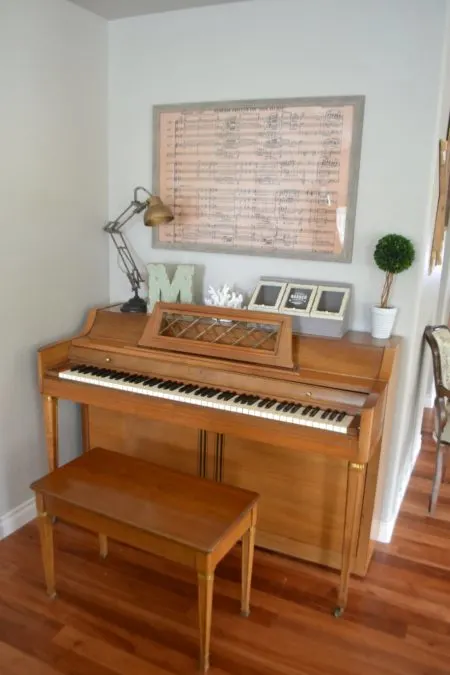
Perhaps you have one in your home. At least you likely know someone who does. There is not a whole lot that is desirable about honey colored furniture these days. Perhaps someday it will come back, but until then, DIYers the world over will continue to dedicate themselves to painting, stripping, sanding, and otherwise removing all trace of anything resembling those delightful orangey tones.
When it comes to pianos, the best thing, the sanity-saving thing to do, is to paint over it.
Really, if you are thinking about refinishing your piano you should probably paint over it.
But, if you just can’t bring yourself to do it – if wood grain is just something you don’t want to mess with, then read on, my crazy friend. Read on.
Why in the world would you stain a piano?!
We inherited this piano from my in laws, and as soon as it was in the house people began asking when I would refinish it. Because, as it turns out, you can’t simultaneously run a diy blog and own a honey colored piano. Such is life.
But, here’s the thing. I just couldn’t paint it. Don’t get me wrong, there are some lovely painted pianos out there. They look great. But I cannot paint a piano for the same reason that I cannot get a tattoo. Inevitably I will wish I hadn’t, and both are really difficult to remove.
So I less than enthusiastically puzzled over stain choices. Then one day I learned about Weatherwood Stains, a product that reacts with the wood to produce a weathered gray look, resembling old wood. I was fascinated, and for the first time I caught a whiff of that elusive excitement I needed to enter upon a pretty monumental project.
Admittedly, you could totally have skipped that part. But you might find it interesting if you are on the fence yourself. Also, I think it is important to introduce the product that is at the heart of this project.
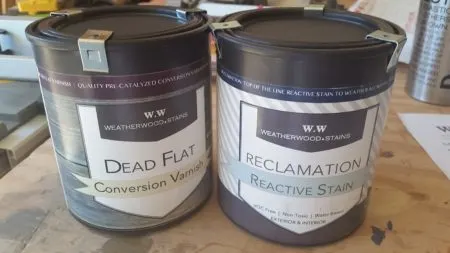
Guys, this is one of my favorite things, ever. This isn’t a sponsored post, but the good people at Weatherwood Stains did share this project with me. And let me tell you – it takes a pretty incredible product to make me undertake stripping a piano. So let’s get to it, shall we?
How to stain a piano
*This post contains affiliate links for your convenience. You can read my full disclosure policy here.
Materials needed:
*All of these are available at the major hardware stores and Amazon. I have included links that reflect the lowest price for each item.*
sanding sponges and pads (you will also need some fine grit pads for your sander)
stain (I used Reclamation by Weatherwood Stains)
finish (I used Dead Flat Varnish by Weatherwood Stains)
Tools needed:
sander (I use, and love, this one)
Step 1. Disassemble the piano
Slowly and very methodically disassemble what you can down to the sound board. Personally, unless you are a piano technician, I would leave the rest of it alone.
Tip: Place each set of screws in its own sandwich bag and note on the outside with a sharpie where they go. Photograph each part and write the corresponding photo number on each bag. By the time you are done you will likely have forgotten all those details.
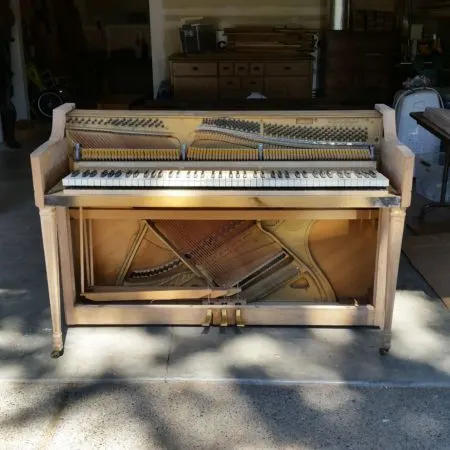
Step 2. Sand and strip
Sand the flat surfaces. This is personal preference, but stripper is some gnarly stuff to work with, and I prefer to reserve it for surfaces that cannot be easily sanded. Cover the keys and soundboard as best you can during this process.
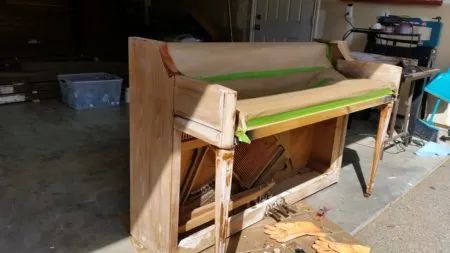
Tip: Ignore the bad example of the photo above. Stripper works best if it is allowed to stay moist and work into the finish. Cover or wrap the surface as you work and allow it to thoroughly penetrate. After a suitable amount of time, as determined by testing, scrub the stripper and dissolved finish off using a soft scraper and wire brush. Follow up with after wash using a scrub pad to remove the residual stripper. Be sure to wear chemical resistant gloves, safety glasses, and a respirator mask while working with these chemicals. They are serious stuff.

Step 3. Stain the piano
That last step is going to take you a long time. Be sure to allow the newly stripped piano to sit for a couple of days to thoroughly dry out. You don’t want to try to work over an area that was recently exposed to those chemicals.
Unlike other stains, Weatherwood Stain is applied without wiping back. Apply enough stain to thoroughly saturate the wood, then stand back and watch the magic. That’s the fun part.
Here’s a video introducing that process in a little more detail and giving some background if you would like.
Can you tell that I’m painfully awkward on video? I have a very strong dislike of being in front of the camera.
Part 2. This one is a time lapse of the stain doing its thing.
Here’s a few photos of that process.

Weatherwood notes on its website that if the wood you are staining is a soft maple the reactive stain will produce a purple color. Their simple solution is to coat the newly stained wood with hydrogen peroxide and let let it soak in and dry. Here’s a quick video showing how well that process works.
Step 4. Seal the wood with vanish
For the finish I used Weatherwood’s Dead Flat Varnish, per their recommendation. Take a stroll down your local Lowes or Home Depot and you will realize that a flat varnish is a tall order. The only flat varnishes of which I am aware are General Finishes water based topcoat and this flat finish by Weatherwood Stains. Now, I realize it may be nerdy to get excited by a varnish, but I am totally doing the happy dance over this stuff. I expected it to have some small amount of sheen because that’s what finishes do. This one does not. It is as close to perfection as it gets. I will definitely be using it again for future products.
Take a look at this finish.
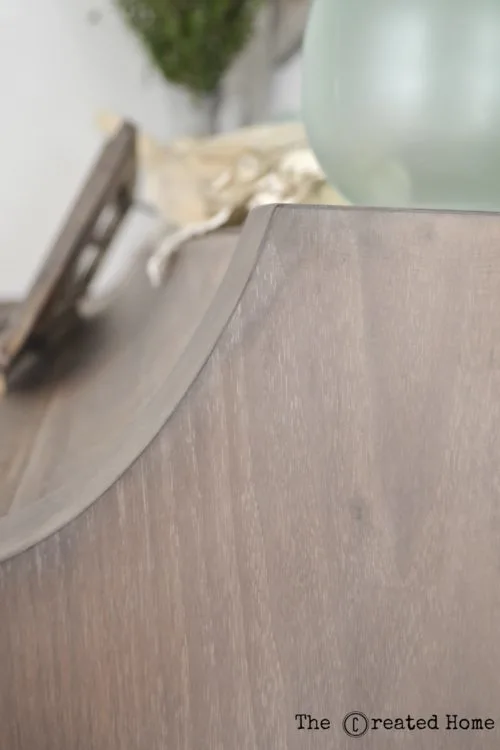
That is with three coats of finish! I’m telling you, I’m in varnish heaven.
Now, to back up a moment: Weatherwood Reclamation stain is very environmentally friendly and VOC free, but it does have an odor. I let the piano sit for a week or two in the garage to allow the smell to dissipate before moving on to the next step. To be fair, it didn’t really need that long, I just needed to find enough people to lift the piano back into the house so it worked out! Always apply varnish in a clean environment. I finished the piano inside the house and did not have a problem with any strong smell.
Step 5. Reassemble the piano
If you documented each part of step 1 then step 5 should go pretty smoothly. I made the decision to reassemble our piano without the bottom panel, leaving the lower part of the sound board open. I like to think the piano looks like it has just washed ashore on the beach. My husband says it evokes more of a found-in-the-woods feel. Either way, it has a deconstructed, returning to nature look to it that I love. I realize it is not for everyone, and expect to hear a few “oh my gosh, she ruined that piano!” comments, but I’m cool with that. This was an artistic project that I consider an expression of the things I love: nature, music, wood. All those lovely elements. It also pairs well with my love for photography.
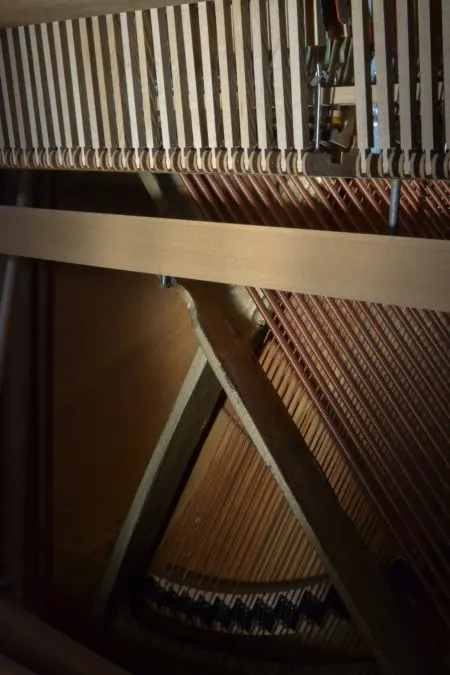
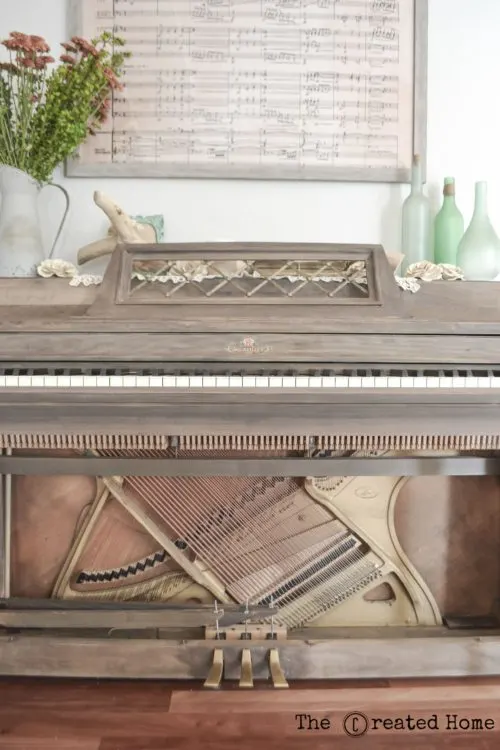
So there it is!
One more note: When you sand a piano you will need to replace the decal. You can order a new one online. The process is not so much a stick-it-on-and-go thing as a sweat, tears, and cursing ordeal, but take it slow and it will be fine. I am actually still working to remove the last bit of residue from ours so it will look a bit more seamless.
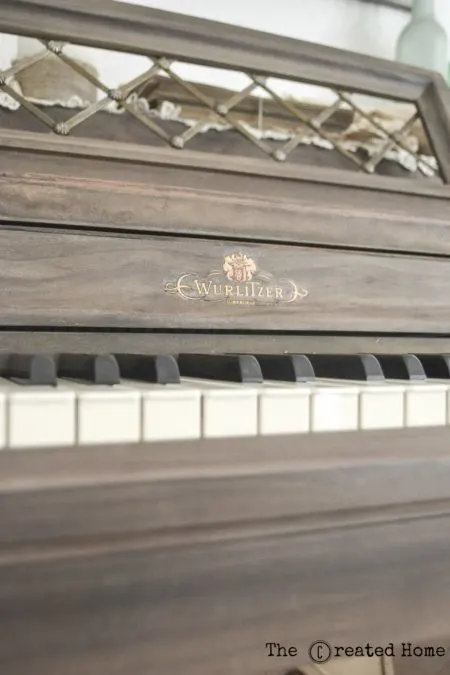
The finished piano
I love the look of the piano. It now fits so much better with our aesthetic. My kids were thrilled to have it back in the house because they love to play it, and by “play” I mean pound on the keys energetically.
Here’s it is in all of it’s washed-ashore or left-in-the-woods glory. I even topped it with a piece of driftwood and some sea glass in what is definitely an over emphasis of a point. The framed piece of music over the piano is from Beethoven’s 9th Symphony, which is my favorite piece of music. I created it by enlarging it onto a piece of engineering paper printed at Staples. The roses on top of the piano I folded out of sheets of music from vintage church hymnals.
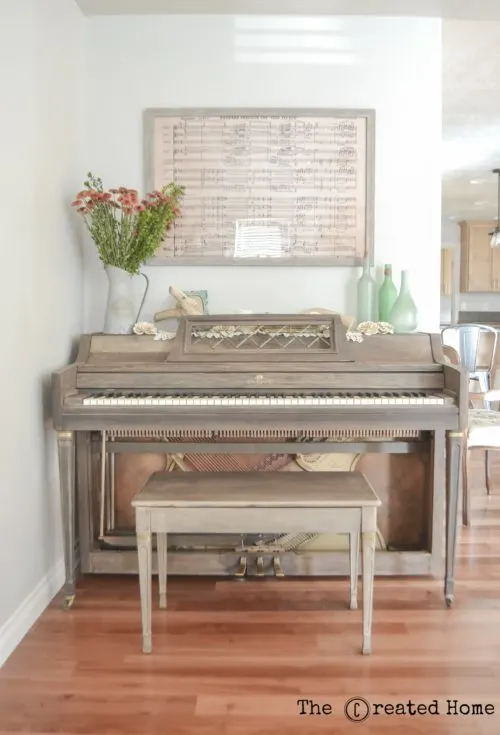
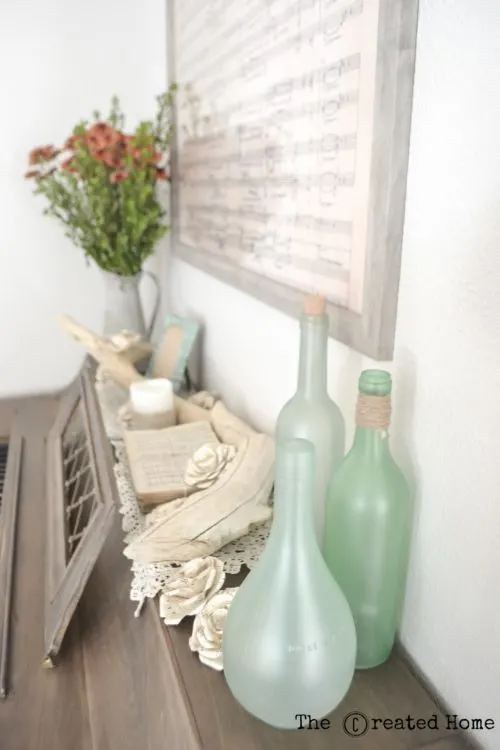
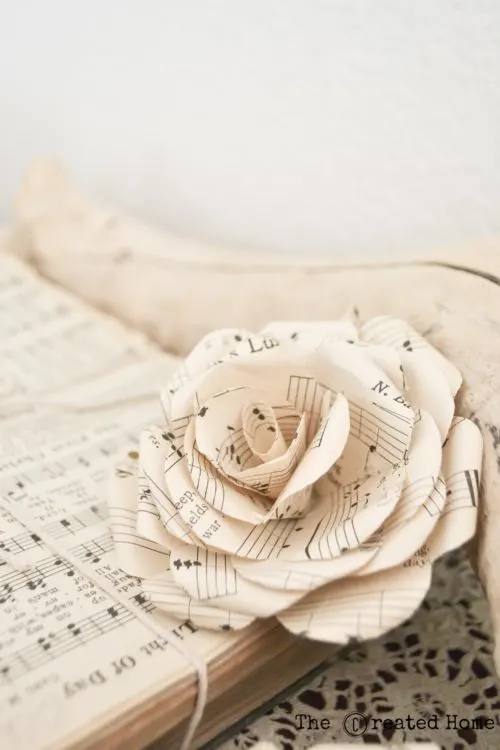
I love that it is a one of a kind piano now.
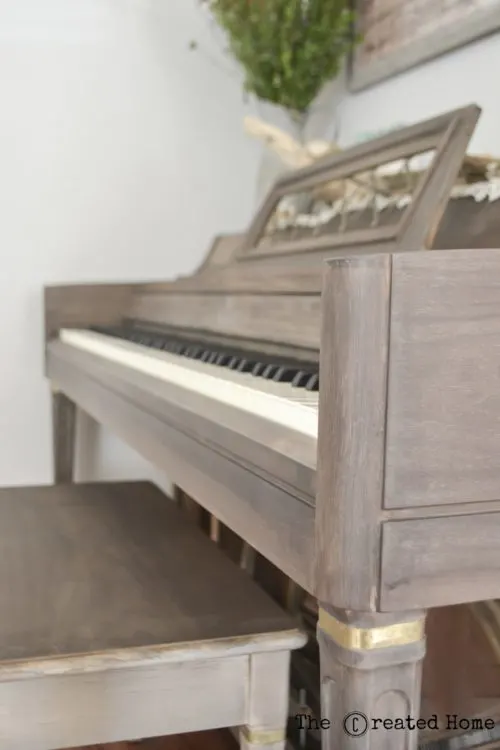
Thanks for reading! I have been asking myself if it was all worth it as I look at our newly finish piano, and the answer is yes. I don’t think I would have been happy with it if I had used any other product. I wanted something special, and the Weatherwood stain fit that perfectly. I will definitely be using more of their reactive stains on future projects. If you love the barn wood look it is well worth checking out.
If you have an old piano that has to be stripped and refinished, either because you plan to restain or because it has years of built up paint, my advice is to set aside a good deal of time to finish the project and not try to rush any part of it. It is definitely a doable job, and doing it yourself will save you a lot of money, but it is not a speedy process and it requires a ton of attention to detail.
Thanks for reading!
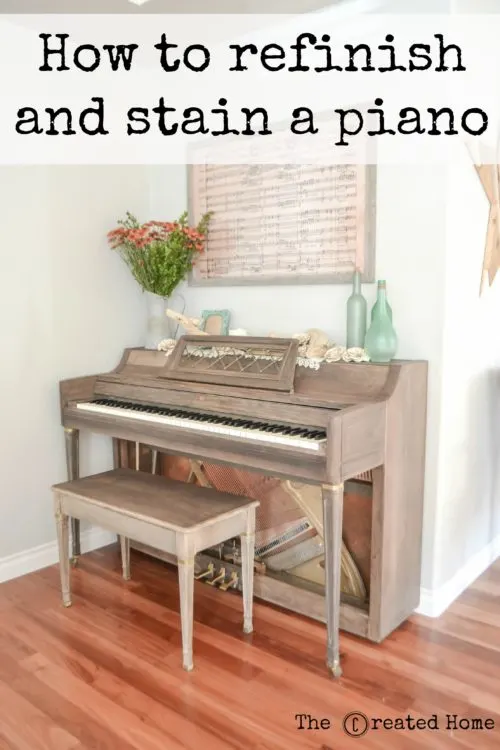

Anna
Saturday 13th of March 2021
My piano turned out purple Followed all the steps and now wondering if I can fix that or have to get a new piano
Sarah
Wednesday 31st of March 2021
Hi Anna. Hopefully you were able to find where I addressed this in the tutorial. What is happening is that the wood is a soft rather than a hard maple. The same thing happened with my piano. The solution is to coat the newly stained wood with hydrogen peroxide and let let it soak in and dry. There is a video in the tutorial showing that process. I hope that helps!
Cathy Meeks
Friday 29th of January 2021
This is so amazing that it inspired me to go buy a piano and do the exact same thing (and then learn to play it lol). I want to follow your instructions because I am not very handy. When I click on the stripper you used it is not coming up. Can you recall the type/brand of stripper you used? Thanks so much!
Sarah
Thursday 1st of April 2021
I believe I used the citris stuff. It's a big project. Just take it slow and you'll do great!
How To Piano - 25 Step Piano Restoration Process - Sweeney Piano
Friday 23rd of October 2020
[…] 9. How to Refinish a Piano without Paint – The Created Home […]
Cindy
Friday 5th of June 2020
Hi there! I have a few questions. Do you think it would be ok to just sand the whole thing? Also do you remember how you remover the very front piece at the end of the keys?
Sarah
Tuesday 16th of June 2020
I think it works to sand wherever there is flat surface. The problem becomes when you get to rounded surfaces. I'm not sure what piece you are referring to. The small block type pieces? All I recall about those is that it disassembled piece by piece, and that there were at least a couple for each side.
JP
Friday 29th of May 2020
How did you paint the sound board? I’m doing this exact project myself and have the piano disassembled in our garage and ready to sand tonight!
Sarah
Tuesday 16th of June 2020
No. I left that area as it was. In fact I liked it so much that I never put the piece of wood back over it! Please do share a photo of how yours turned out!